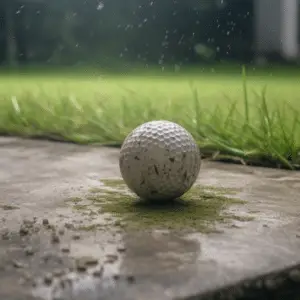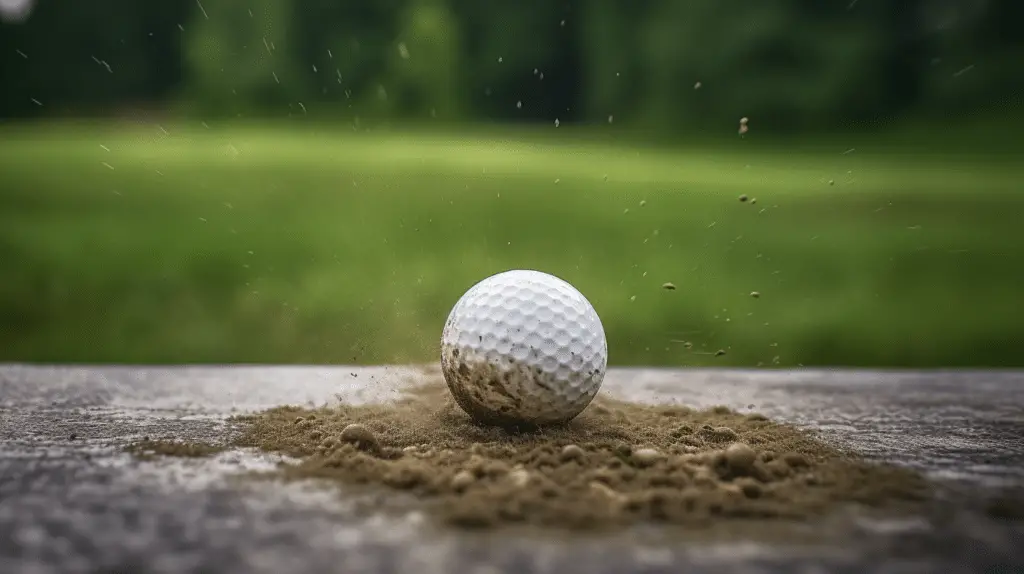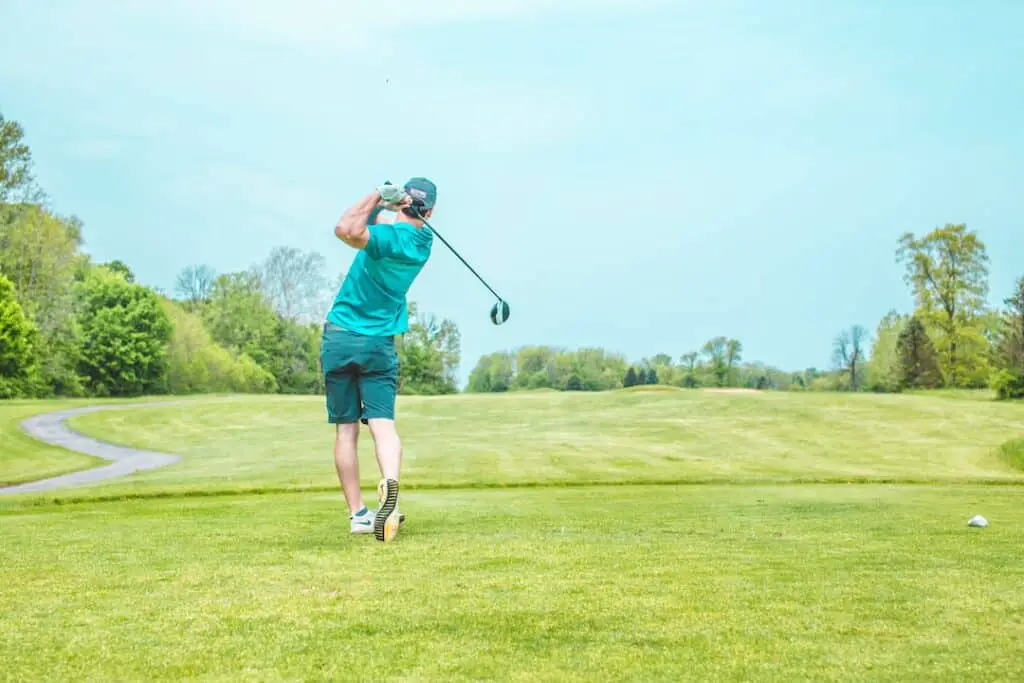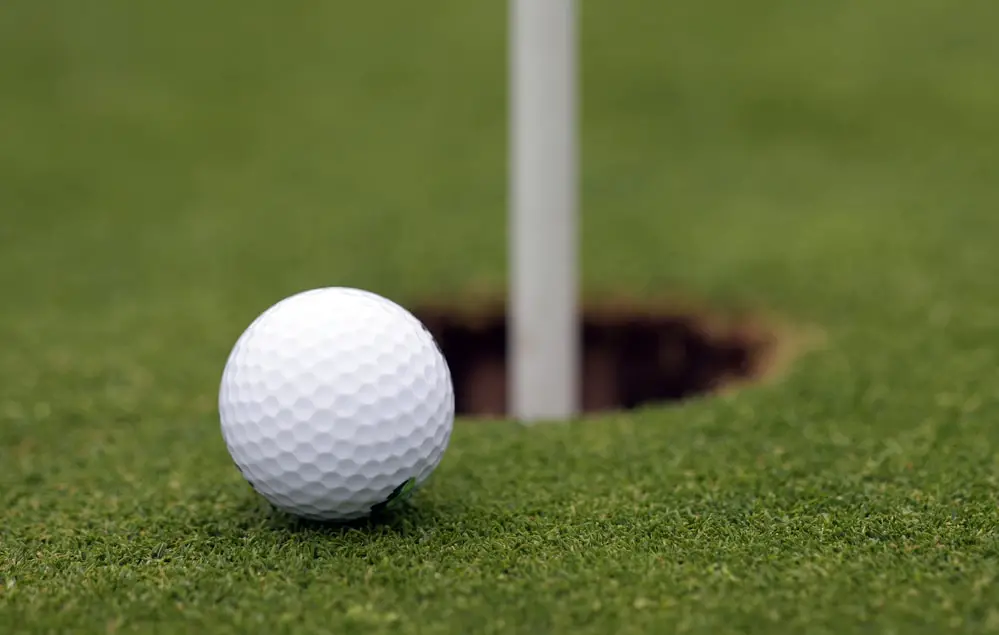Last Updated on June 9, 2023
Golf is a popular sport enjoyed by many people, but the physics behind how it works is often overlooked. One of the most intriguing aspects of golf is understanding what makes a golf ball bounce. This article explores the physics of bouncing and provides an overview of how different materials affect its performance on grass or sand traps. By examining various factors that impact the trajectory of a golf ball, readers will gain insight into why certain types of balls work better than others for particular shots and environments.
Physics Behind The Bounce
The physics behind the bounce of a golf ball is complex but can be broken down into three main concepts: the impact, the spin and the aerodynamic forces. When a golfer hits a golf ball with their club, they are imparting an initial velocity to it, which causes the ball to travel in the desired direction. This initial velocity also affects how high and far the golf ball will go when it impacts the ground. The type of surface that it impacts will also influence its trajectory upon contact.
When the club strikes the golf ball, not only does it create a force that propels it forward, but there is also a rotational component due to friction generated between them during impact. This results in backspin as well as side spin being imparted onto the golf ball by centrifugal force. These spins help stabilize its flight path through air resistance and provide lift for higher shots or longer distances from tee boxes. Finally, aerodynamics plays an important role in determining how much lift or drag is created when passing through air molecules; this determines where and how far a golf ball travels depending on wind speed and other factors like altitude.
Through understanding these principles, one can better understand why certain variables affect how far or accurately one can hit a golf shot and use this knowledge to improve their game.
Material Composition Of A Golf Ball

The material composition of a golf ball is one of the most important factors in determining how it will perform. The material makeup determines the weight, spin rate and bounces characteristics of the golf ball. Generally speaking, a golf ball consists of several layers made from rubber or plastic. In some cases, additives such as aluminium powder may be added for specific performance benefits.
At the core of all modern golf balls lies a solid centre that provides structure and shape to the ball. This core can be composed of various materials, including balata, synthetic rubber and other polymers. Balata has traditionally been favoured by professional players due to its superior feel and control; however, advances in technology have led to more durable cores with better flight characteristics. These cores are often surrounded by thin outer layers designed to provide additional stability and durability while also enhancing certain aspects of playability, such as distance or spin rate.
Coefficient Of Restitution
The coefficient of restitution is a critical aspect in determining how well a golf ball will bounce. This coefficient measures the kinetic energy that is retained after two objects collide with each other, expressed as a decimal between zero and one. If the coefficient of restitution for two colliding bodies is one, then all of their original kinetic energy has been preserved. In order to ensure that golf balls can perform optimally, they should have a high coefficient of restitution when impacting surfaces such as clubfaces and turf. The higher the coefficient, the more efficient its performance on the course. It must be noted, however, that there are limits imposed on this measurement by regulations put forth by organizations such as United States Golf Association (USGA). Thus manufacturers must find an ideal balance between preserving enough kinetic energy while still complying with these standards.
Compression And Its Influence On Bounce
Golf-ball compression is a measure of the amount to which a golf ball can be compressed when it is struck with a club. This value, known as the compression coefficient or rating, indicates how much energy from a swing will be transferred into the ball upon impact. Higher values indicate that more energy has been transferred, resulting in greater distance and velocity for the shot. Lower values indicate less energy transfer and shorter distances for the shot.
The overall bounce performance of a golf ball is determined by its construction materials, such as rubber and dimples on its surface, but also it’s core composition and hardness. The softer the core material used in production, the higher the compression rating of the finished product; this translates to an increased ability of the golf ball to absorb energy from swings while still maintaining trajectory control during flight. Conversely, harder cores result in lower compression ratings and reduced absorption capabilities; however, they generally offer better spin rates due to their firmer nature. Ultimately, selecting the right golf ball depends on understanding one’s own characteristics, including strength, tempo and style of play, so that one can choose a golf ball with optimal bounce properties tailored to their needs.
Wind Affecting Bounce
Wind plays an influential role in the trajectory of a golf ball. It affects the flight path and bounce of a golf ball and can dramatically alter its overall performance. The speed and direction of the wind may vary during a single swing or round, which is why it is important to understand how wind can affect a shot’s outcome. The wind has both lift and drag forces that act on the golf ball while airborne, creating extra spin and lofting or reducing the height of each shot. A golfer should take into consideration the type of club being used, as well as any gusty winds when hitting their shots.

By understanding how wind interacts with the ball’s aerodynamics, a golfer can better optimize their swing to reach longer distances than they would have otherwise achieved without taking into account these variables. As such, knowledge about wind conditions will allow for improved accuracy with every stroke by allowing players to adjust their technique accordingly, depending on what kind of breeze they are facing. Armed with this information, golfers will be able to make more informed decisions regarding their stance and angle before making contact with the ball in order for them to gain maximum distance from each hit.
Frequently Asked Questions
How Long Can A Golf Ball Bounce For?
This is an important factor in the longevity of a golf ball and its corresponding rate of bouncing, as it determines the overall lifespan of the product.
To understand the duration which a golf ball can bounce for, one must first consider several key factors:
- The size and weight of the golf ball
- The surface on which it bounces
- The temperature at which it is bounced
- Its construction materials
These four elements all play into how long a golf ball will retain its bounce; however, certain conditions are optimal for maximum bounce rate and duration. For instance, if a lightweight golf ball with a soft outer layer is used on asphalt or concrete surfaces when temperatures are warmer, then this provides an ideal environment to produce greater amounts of a rebound while prolonging the life expectancy of the object itself. Conversely, extremely cold temperatures may reduce rebounding capabilities due to decreased flexibility and rigidity in material composition.
It is clear that various environmental factors influence how long a golf ball can maintain its ability to rebound off surfaces such as asphalt or concrete; therefore, understanding these parameters allows one to make informed decisions about purchasing and using products accordingly. In order to maximize both efficiency and cost-effectiveness, knowledge regarding optimal conditions should be taken into consideration prior to any purchase being made.
What Is The Best Type Of Surface For A Golf Ball To Bounce On?
When discussing the best type of surface for a golf ball to bounce on, there are several factors that need to be considered. The optimal surface should allow the golf ball to travel as far and fast as possible whilst maintaining its integrity. It is important to bear in mind that different surfaces have varying effects on the performance of a golf ball.
One factor that affects the bouncing characteristics of a golf ball is friction. Friction determines how quickly and efficiently the energy from an impact can be transferred into motion. Harder surfaces such as concrete or asphalt provide more resistance than softer materials like grass, which produces less friction when a golf ball comes into contact with it. This results in greater distances being achieved by balls hit onto these types of surfaces compared to other materials.
Similarly, certain types of turf may also increase the distance and speed at which a golf ball travels when they come into contact due to its composition and texture. For example, some synthetic turf has been specifically designed so that it maximizes grip during play, allowing players to achieve maximum velocity and accuracy with each shot. Additionally, this kind of artificial turf absorbs shock better than traditional grass, meaning that any shots struck will not lose momentum as easily before reaching their destination. Ultimately, depending on individual preferences, choosing between these various options is key for making sure that one can achieve optimum performance from every single stroke taken out on the course.
Conclusion
The optimal temperature for a golf ball to bounce is between 70 and 80 degrees Fahrenheit. The duration of the bounce depends on how hard it was hit, as well as the surface it bounces off of, with harder surfaces resulting in shorter bouncing times. It has been determined that grass or artificial turf are the most effective surfaces for maximizing a golf ball’s bounce time. Furthermore, the type of club used does affect its bounce, with longer clubs providing less spin, which can cause the ball to roll instead of bounce. Lastly, altitude also affects a golf ball’s ability to bounce due to air resistance; at higher altitudes, balls will not be able to travel as far before coming into contact with the ground.
In conclusion, there are many factors that influence how long a golf ball can remain airborne and, thus, how much it will ultimately end up bouncing. Temperature plays an important role in determining how high and how long a golf ball will stay aloft, while impact velocity and surface hardness determine how long it stays in motion after hitting something solid. Additionally, the type of club used and atmospheric conditions, such as altitude, both have a bearing on this phenomenon. Consequently, understanding these elements gives players better control over their shots by allowing them to adjust each parameter accordingly.


